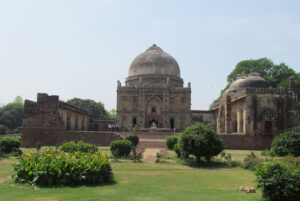
Lodi Gardens or Lodhi Gardens is a city park situated in New Delhi, India. Spread over 90 acres (360,000 m2), it contains, Mohammed Shah’s tomb, tomb of Sikandar Lodi, Shisha Gumbad and Bara Gumbad, architectural works of the 15th century by the Lodis – who ruled parts of northern India and Punjab and Khyber Pakhtunkhwa province of modern-day Pakistan, from 1451 to 1526. The site is now protected by the Archaeological Survey of India (ASI). The gardens get their name from the four monuments of the Lodi dynasty, the last of the Delhi Sultanate. It was developed during the British period and inaugurated by Lady Willingdon on 9th April in the year 1936. As joggers and strollers wind their way around the garden. These concrete remains are a photographer’s delight.

Lodi Gardens are a real heaven of tranquility in the hustle and bustle of Delhi. There is a Bara Gumbad and Sheesh Gumbad in the centre of Lodhi Gardens in Delhi which speak of the architectural glory of that era. The former comprises of a large rubber construct dome, a three domed mosque and a residence surrounding a central courtyard which contains the remains of a water tank. Opposite to this Bara Gumbad lies the Sheesh Gumbad which consists of the remains of an unknown family.
The tomb of Mohammad Shah was built by his son Ala-ud-Din Alam Shah in 1444 AD in memory of his father who ruled from 1434 to 1444 AD. With its proximity to the entrance of the garden, the tomb is clearly visible even from outside the premises. The tomb is an octagonal chamber, with over-hangings on the roofs called Chhajjas and carvings on the corners. With very less architecture from both the dynasties of Sayyid and Lodhi, the garden turned out to be an important place.
Built by Ibrahim Lodi in 1517 AD is the tomb of Sikander Lodi which appears similar to the tomb of Mohammed Shah. As time went by, two villages came up around the monuments and the villagers were later relocated in the year 1936 to make way for the gardens. The garden was landscaped by the British and named Lady Willingdon Park on its opening and was later renamed Lodi Gardens after independence.
Source:
https://www.mapsofindia.com/delhi/places-of-interest/gardens/lodhi-garden.html


